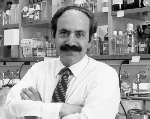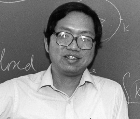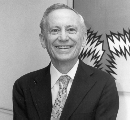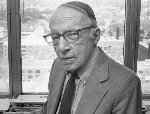 |
|
|
 |
||
|
|||||||||||||||||||||||||||||||||||||||||
|
|||||||||||||||||||||||||||||||||||||||||
Go To: |
Behavioral and Social Sciences | Biological Sciences | Chemistry | Engineering | Mathematics | Physical Sciences |
Behavioral and Social Sciences
William K. Estes, professor emeritus of psychology, Harvard Universit
|
|
What: Estes' studies of how people and animals learn, and his pioneering use of mathematical methods in experimental psychology over the last 50 years, have transformed the field of experimental psychology.
Why: In the 1950's, he published the seminal articles demonstrating how models of internal mental processes that are not directly observable could be tested with empirical data. He demonstrated the utility of this approach to diverse fields in learning, memory and cognition, including animal learning, motivation, human development, human intelligence, decision making and the cognitive psychology fields in which his work is best known: visual perception and attention; short-term memory; long-term memory; and categorization and conceptualization. He established a standard for the practice of psychological science for several generations of the best researchers in the field, a standard of unflagging dedication over more than 50 years, and an insistence on absolute rigor and precision. Estes' 1950 Psychology Review article, "Toward a Statistical Theory of Learning," has long been considered a landmark in the development of mathematical modeling in psychology, and set the field on a course that changed its fundamental character, moving it a significant distance from a descriptive science to a behavioral science based on the mathematical modeling of mental processes.
Personal: Bachelor's degree and doctorate in psychology from the University of Minnesota. Born June 17, 1919 in Minneapolis, Minn.
Biological Sciences
James D. Watson, president of the Cold Spring Harbor Laboratory in Cold Spring Harbor, N.Y.
 |
|
What: Co-discoverer of the "double helix" structure of DNA while at Cambridge University. The double helix, a form reminiscent of a spiral staircase, connects the basic building blocks of genes in combinations that determine heredity. Shared with Francis Crick, an English biochemist, the 1962 Nobel Prize in medicine and physiology for their work on DNA. Author of The Double Helix, a classic, best-selling, non-fiction account of his research.
Why: Watson's discoveries about the structure of DNA continue to have lasting and fundamental effects on biological research, more than 30 years after the fact. Rapid advances in such fields as biotechnology and the new science of cloning can trace their genesis to Watson's discoveries. In 1990, Watson helped to launch the $3 billion Genome Project, a 15-year effort to map the genetic structure of human beings. When completed, the project will provide a detailed guide to 100 genes, down to the level of nucleotides, the basic constituents of genetic inheritance. The project is expected to yield information that is basic to deeper understanding of human disease and other aspects of biology that are expected to have immeasurable benefits in biomedical research.
Personal: Bachelor's degree in zoology from the University of Chicago, Doctorate in zoology from Indiana University. Born April 6, 1928 in Chicago.
Robert A. Weinberg, member, Whitehead Institute for Biomedical Research and professor of biology at the Massachusetts Institute of Technology
 |
|
What: Weinberg has made a number of crucial discoveries in the field of cancer research in 20 years of work on retroviruses, oncogenes, and tumor suppressor genes. He was among the first to discover a human cancer-causing gene and to show that it was altered by mutation. He also showed how two distinct cancer-causing genes were necessary to produce malignant change, providing concrete evidence for the "two hit" hypothesis of carcinogenesis, and, together with his colleagues, identified the first cancer suppressor gene.
Why: These observations of Weinberg's are now viewed as milestones in the history of cancer research, and each bears the clear imprint of his vision and thought. Taken in concert with his important work on the cloning of the cDNA for the retinoblastoma susceptibility gene, the first tumor suppressor locus to be investigated at the molecular level, and his recent work on components of the cell cycle machinery, Weinberg's body of work has influenced virtually all the major aspects of contemporary thought about the origins of cancer: the definition of mutations affecting a specific subset of cellular genes; the development of diagnostic tests for such mutations; the description of combinations of events, involving both oncogenes and tumor suppressor genes, required to produce a cancer; and the unveiling of the physiology of normal cell growth, affected by both classes of genes, that is derailed by these mutations.
Personal: Bachelor and doctoral degrees in biology from the Massachusetts Institute of Technology. Born Nov. 11, 1942 in Pittsburgh, Penn.
Chemistry
Darleane C. Hoffman, professor of the Graduate School, University of California, Berkeley
 |
|
What: As the discoverer of Plutonium 244, she is the only person in the last 60 years to have found significant quantities of a new chemical element in nature. She is an internationally recognized leader in nuclear chemistry, particularly in the areas of nuclear fission, properties of actinide elements and reactions of heavy nuclei.
Why: In 1971, Hoffman and her colleagues Los Alamos National Laboratory discovered the unexpected and unique enhanced symmetric mass split in the spontaneous fission of Fermium 257. Up to the time of her work, the observed characteristics of fission of the heavy nuclei had been a major problem that had stumped many of the giants of nuclear physics. Her demonstration that the heaviest nuclei fission symmetrically proved the importance of nuclear shell structure in defining fission. She was subsequently appointed as an associate group leader of the radiochemistry group at the Los Alamos Scientific Laboratory. In 1978, she was awarded a Guggenheim Fellowship for the study of mechanisms of nuclear fission and spent that year with the heavy element group at Lawrence Berkeley Laboratory. Hoffman's recent investigation of the chemistry of elements 104 and 105 has revitalized heavy element chemistry. This work, in collaboration with several West German, Swiss and U.S. groups, is aimed principally at understanding the underlying reaction mechanisms for a relatively new and uncharted class of heavy-ion nuclear reactions, and at using them for the synthesis of new, longer-lived isotopes of the heaviest elements. Her group performs one atom-at-a-time studies of chemical properties of the heaviest elements and has performed the first aqueous chemistry on element 105.
Personal: Bachelor and doctoral degrees in chemistry from Iowa State University. Born Nov. 8, 1926 in Terril, Iowa.
Harold S. Johnston, professor emeritus in chemistry at the University of California, Berkeley
 |
|
What: His pioneering work on chemical reactions in the atmosphere helped to create a new field of science and had a major impact on global public policy decisions.
Why: Among Johnston's greatest contributions to environmental science was a 1971 article in Science magazine, "Reduction of Stratospheric Ozone by Nitrogen Oxide Catalysis from Supersonic Transport Exhaust," that marked the coming of age in the field of atmospheric chemistry, an important new field which would receive recognition 25 years later when three of its leading scientists were awarded the Nobel Prize in chemistry. Johnston described how a trace amount of material added to the stratosphere could destroy vast amounts of ozone. The immediate public policy question was the decision on whether or not to put federal funding into supersonic transport. In his testimony before the U.S. Senate, Johnston stood as the clarion voice, arguing that nitrogen oxides emissions from supersonic aircraft would have profound effects on the earth's stratospheric ozone layer. The U.S. Congress responded in the fall of 1971 by authorizing a large research project--the Climatic Impact Assessment Program--to investigate the vulnerability of stratospheric ozone to artificial chemical emissions. This new program was the start of a major U.S., and eventually international, program of stratospheric chemistry research.
Personal: Bachelor's degree in chemistry from Emory University in Atlanta, GA, and doctorate in chemistry from the California Institute of Technology. Born Oct. 11, 1920 in Woodstock, Ga.
Mathematics
Shing-Tung Yau, professor of mathematics, Harvard University
 |
|
What: Yau has made profound contributions to mathematics with his unparalleled ability for combining the theories of nonlinear partial differential equations and differential geometry. His work has had a great impact on areas of mathematics and physics as diverse as topology, algebraic geometry, representation theory and general relativity as well as differential geometry and partial differential equations.
Why: Yau's work is distinguished by its enormous breadth, power and insight. Repeatedly tackling fundamental problems without regard to their difficulty, impact on science through his own research has definitely placed Yau in a league of his own. Yau, working collaboratively with Richard M. Schoen, solved a long-standing open problem in relativity theory, by showing the positivity of mass for space-time. As a consequence, Schoen and Yau were able to give the first rigorous demonstration of how black holes can be formed because of the condensation of matter. A black hole possesses a gravitational field so intense that no matter or radiation can escape from it.
Personal: Doctorate in mathematics University of California, Berkeley. Born April 4, 1919 in Swatow, People's Republic of China.
Physical Sciences
Marshall N. Rosenbluth, professor and research physicist at the University of California, San Diego
 |
|
What: A theoretical physicist whose primary interest is the study of plasmas, Rosenbluth helped demonstrate, as early as 1953, that computers held great promise for solving previously intractable problems in theoretical physics. For more than 40 years, he has been a leader in the effort to harness nuclear fusion as an unlimited source of energy for peaceful uses.
Why: Plasmas are very hot ionized gases. Rosenbluth's research into the theoretical structure of the equations governing the behavior of plasmas, his contributions to the understanding of the many instabilities that are a part of the behavior of plasma, and his intellectual leadership of the controlled fusion program, were invaluable to the field. In 1975, Rosenbluth realized that the excitation of Alfven waves by high energy ions in a Tokamak reactor, a type of reactor developed in the former Soviet Union that is expected to prove promising in generating electricity, was an important and previously unnoticed source of stability at the threshold of change to a burning plasma. This work became the paradigm for models of activity in a Tokamak reactor and found many important applications outside the fusion research community. In addition to his work in fusion, Rosenbluth continues as a consultant to the Department of Defense on national security issues, anti-submarine warfare and free electron lasers.
Personal: Bachelors degree from Harvard University and Doctorate from the University of Chicago. Born Feb. 5, 1927 in Albany, N.Y.
Martin Schwarzschild, Higgins Professor of Astronomy Emeritus, Princeton University
(Deceased: April 10, 1997)
 |
|
What: Schwarzschild is perhaps best known for his research on stellar structure and evolution, a central field of astronomy and one in which he made seminal contributions. His work explained how stars expand into the red giant phase -- becoming stars with extended hydrogen envelopes surrounding dense helium cores -- at the end of their initial hydrogen-burning "main sequence" lifetimes. Until Schwarzschild published his solution to it in the 1950s, the so-called "red-giant problem" had remained unsolved since its recognition in the 1910s.
Why: For his research, Schwarzschild is sometimes considered to be the "father of stellar evolution." His 1958 book Structure and Evolution of the Stars has been a standard text for generations of students. Schwarzschild was the first to capitalize on the power of the electronic digital computer for research in this area, and he developed imaginative techniques which have since become standards. He set an example for future generations of theoretical astrophysicists, showing how to obtain detailed numerical results without losing sight of the basic physical principles, and encouraging continual intercomparison between analytical estimates and actual computations. One benefit of his approach was Schwarzschild's discovery of thermonuclear "flashes" in the thin energy-producing shells that develop around the inert helium cores of evolving stars. Schwarzschild also demonstrated leadership in observational astronomy. In 1942, from observations of the stars in a "globular cluster" -- a spherical ball containing some hundreds of thousands of stars -- Schwarzschild made the fundamental discovery that every star in what is now called the "variable star instability strip" undergoes pulsations. His study laid the foundation for a new field of globular-cluster studies that continues today, now pursued by a very large group of astronomers.
Personal: Doctorate in astronomy from the University of Goettingen, Germany. Born May 31, 1912 in Potsdam, Germany.
George W. Wetherill, staff member of the department of terrestrial magnetism at the Carnegie Institution of Washington, Washington, DC
 |
|
What: Weatherill developed radiometric clocks that provide reliable dates for the origin and early history of the earth, the chronology of planetary evolution, the history of plate tectonics and for timing the early origin of humans on earth. In another major contribution, he showed how earth-like planets may be created in evolving solar systems.
Why: Using principles of orbital dynamics, Wetherill developed conceptual tools and computer algorithms that enabled him to examine the step-by-step process by which terrestrial planets can be formed by the accumulation of smaller planetary materials/fractions, and how the growing protoplanets' orbits may cross so that they can then be gravitationally captured. Wetherill's demonstration of this process was the intellectual foundation of the current models of the origin of the earth-moon system. Of equal importance is the ability of Wetherill's models to help understand the distribution and interactions of existing planets, asteroids, and comets in our own and other solar systems. As the Hubble images lead to the discovery of other solar systems, Wetherill's contributions will become the basis for testing models of the evolutionary dynamics in numerous other solar systems.
Personal: General doctorate and doctorate, master's, and bachelor's degrees in physics from the University of Chicago. Born August 12, 1925 in Philadelphia, Penn.
See also: NSF Press Release.
|
|
